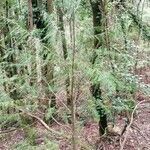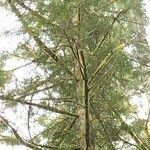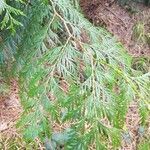Trees to 50(--75) m, sometimes stunted in harsh environments; trunk to 2(--5) m diam., often buttressed at base; crown conical. Bark reddish brown or grayish brown, 10--25 mm thick, fibrous, fissured. Branches arching, branchlets pendent. Leaves of branchlets (1--)3--6 mm (sprays sometimes bearing only very small leaves), apex acute, with white markings on abaxial surface when fresh, glossy green on adaxial surface of branchlets. Pollen cones 1--3 mm, reddish. Seed cones ellipsoid, 10--14 mm, brown; fertile scales 2--3 pairs, each with evident, nearly terminal, deltate projection. Seeds 8--14 per cone, 4--7.5 mm (including wings), reddish brown. 2 n = 22.
Trees to 50(-75) m tall; trunk to 2(-5) m d.b.h., often buttressed at base; bark reddish brown or grayish brown, fibrous, fissured; crown conical; branches arching; branchlets pendulous. Leaves on upper side of branchlets glossy green, (1-)3-6 mm, apex acuminate; lateral leaves longer than facial leaves, apex straight. Pollen cones reddish, 1-3 mm. Seed cones brown, ellipsoid, 1-1.4 cm; fertile cone scales 4-6. Seeds reddish-brown, 4-7.5 mm (including wings).













